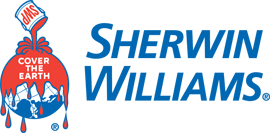A primer is beneficial because it helps provide a uniform surface that promotes good adhesion of the topcoat. A primer can also serve a special purpose by sealing a porous surface, blocking out stains, preventing rust formation on iron and steel, and preventing tannin bleed on wood. Most finish paints are designed to provide a decorative or protective finish for a substrate. In most situations, they do not provide the features of a primer, so it is always important to follow the manufacturer's recommended coating system.
Hatbanding is a phenomenon that appears as a stripe at the edges or top of a wall. It occurs when the brushed "cut-in" area is dry when the wall is rolled. By not rolling onto a wet edge, the difference in the texture of the brushed paint and rolled paint becomes very visible. Hatbanding is corrected by applying another coat of paint, keeping a wet edge of cut-in areas.
Nothing! Only trained and licensed lead removal contractors should handle lead removal. You will find this warning on all our cans of paint: Warning! Removal of old paint by sanding, scraping or other means may generate dust or fumes that contain lead. Exposure to lead dust or fumes may cause brain damage or other adverse health effects, especially in children or pregnant women. Controlling exposure to lead or other hazardous substances requires the use of proper protective equipment, such as a properly fitted respirator (NIOSH approved) and proper containment and cleanup. For more information, call (in the U.S.) the National Lead Information Center at 1-800-424-LEAD or contact your local health authority.While the manufacturers of some chemical paint strippers recommend using their products for removing lead-based paint, you still have to comply with lead removal and hazardous waste disposal regulations. Be safe. Leave this work to specialists.
Saponification is the reaction of an alkaline surface, such as concrete or galvanizing, with the oils in a coating. This reaction forms a soap-like material at the coating/substrate interface and eventually causes the coating to peel.
Fisheyes are caused by some type of surface contamination that was not removed in preparation for painting. This contamination can be from body oils, silicone from furniture polish, or any greasy or oil substance. The slippery deposit on the surface does not allow the paint to adhere, causing it to shrink away from the contamination and form a dimple-like void in the paint film.
Paint is made up of four basic elements: solvent, binder, pigment and additives. The material left on a substrate after the solvent evaporates and the coating cures is its solids content. When calculated as a percentage of the total gallon of paint, the solids are referred to as "Volume Solids." A higher percentage of Volume Solids is usually an indication of a better quality paint because more binder and pigment are left to protect the surface compared to a coating with a lower Volume Solids rating.
Try using a solution of one quart household beach in three quarts of water. Apply the solution to the area with mildew and then rinse off with water. Never add detergents or ammonia to the bleach/water solution. Always protect your skin and eyes against splashes.
First determine the source of moisture that brought the stain to the surface and correct it. Next, remove the stain with a 50/50 solution of water and denatured alcohol. Allow the surface to dry completely, then apply an alkyd primer and topcoat to prevent stains from recurring.
Wiping a mixture of one part vinegar and four parts water on a soft or powdery plaster wall hardens the plaster so that it will accept a paint film. After the plaster dries, prime it with PrepRite Masonry Primer or PrepRite Wall & Wood Primer and topcoat it with Duration Home® or Super Paint.
If bugs land on the wet paint, let them stay until the paint dries. Once dry, remove them with a clean paint brush. You might end up with small, unnoticeable "bug prints," but that's better than removing the bugs and trying to touch up partially dry paint. Using a faster-drying exterior-latex paint, like Sherwin-Williams SuperPaint, is helpful in this situation. Latex paint dries quicker than oil-based paints, giving insects less time to get stuck in the coating.











